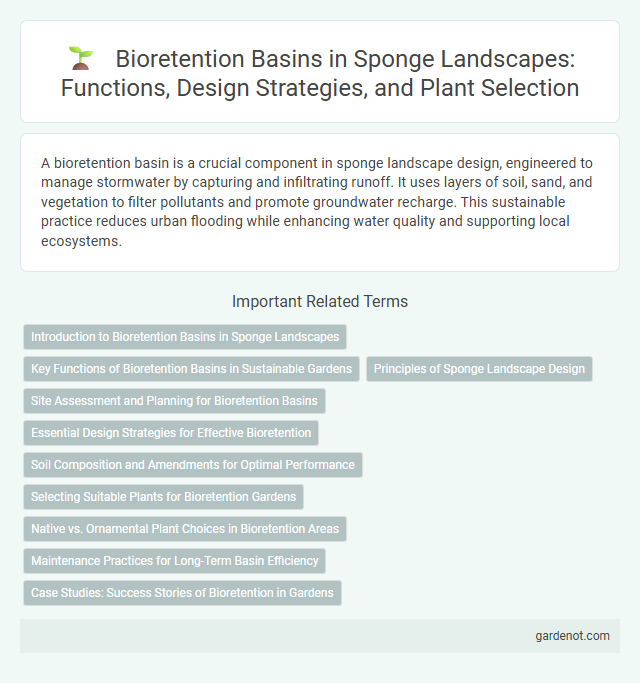A bioretention basin is a crucial component in sponge landscape design, engineered to manage stormwater by capturing and infiltrating runoff. It uses layers of soil, sand, and vegetation to filter pollutants and promote groundwater recharge. This sustainable practice reduces urban flooding while enhancing water quality and supporting local ecosystems.
Introduction to Bioretention Basins in Sponge Landscapes
Bioretention basins in sponge landscapes are designed to capture and treat stormwater runoff through natural processes involving soil, plants, and microorganisms. These basins enhance groundwater recharge, reduce urban flooding, and improve water quality by filtering pollutants such as sediment, nutrients, and heavy metals. Integrating bioretention basins into urban planning supports sustainable water management and increases ecological resilience in impervious city environments.
Key Functions of Bioretention Basins in Sustainable Gardens
Bioretention basins effectively manage stormwater by filtering pollutants, reducing runoff volume, and promoting groundwater recharge in sustainable gardens. These systems enhance soil infiltration and support plant growth through natural filtration processes, improving water quality while preventing erosion. By integrating native vegetation and engineered soil media, bioretention basins contribute to ecosystem health and urban resilience against flooding.
Principles of Sponge Landscape Design
Bioretention basins in sponge landscape design utilize natural filtration processes to manage stormwater by slowing runoff, promoting infiltration, and enhancing water quality through vegetation and soil media. The principles emphasize capturing and treating rainwater on-site, mimicking natural hydrology to reduce flood risk and recharge groundwater. Strategic placement and plant selection optimize pollutant removal and habitat creation while supporting sustainable urban water management.
Site Assessment and Planning for Bioretention Basins
Effective site assessment and planning for bioretention basins involve evaluating soil permeability, topography, and existing vegetation to ensure optimal stormwater infiltration and retention. Detailed soil testing, including infiltration rates and contaminant analysis, guides design parameters for the basin's size and filtration media. Proper planning integrates bioretention basins into the landscape to maximize water quality improvements, reduce runoff velocity, and enhance urban resilience to flooding.
Essential Design Strategies for Effective Bioretention
Effective bioretention design incorporates a multilayered soil profile, including a sand bed, a bioretention soil mix, and an underdrain system, to optimize infiltration and pollutant removal. Incorporating native vegetation with deep root systems enhances soil permeability and supports microbial activity crucial for nutrient uptake. Strategic placement of inflow and overflow structures ensures efficient water conveyance while preventing surface flooding during high runoff events.
Soil Composition and Amendments for Optimal Performance
Bioretention basins require soil compositions with high infiltration rates, typically a mix of sandy loam, compost, and native soil, to balance drainage and nutrient retention. Incorporating organic amendments such as aged compost enhances microbial activity and improves water retention, promoting pollutant breakdown. Optimized soil blends ensure effective stormwater filtration and support healthy vegetation growth within sponge landscape designs.
Selecting Suitable Plants for Bioretention Gardens
Selecting suitable plants for bioretention gardens involves prioritizing native, drought-tolerant species with deep root systems that enhance soil permeability and pollutant filtration. Plants such as Carex stricta, Juncus effusus, and Andropogon gerardii thrive in varying moisture conditions, contributing to effective stormwater management in sponge landscapes. Incorporating diverse plant species ensures resilience, supports local biodiversity, and optimizes the bioretention basin's ecological function.
Native vs. Ornamental Plant Choices in Bioretention Areas
Selecting native plants for bioretention basins enhances stormwater infiltration and supports local biodiversity by providing habitat for native pollinators and wildlife. Ornamental plants, while visually appealing, often require more maintenance and may not tolerate fluctuating moisture levels or contribute as effectively to nutrient uptake. Prioritizing native species such as switchgrass, blueflag iris, and buttonbush improves the ecological function and long-term sustainability of sponge landscape systems.
Maintenance Practices for Long-Term Basin Efficiency
Regular inspection and removal of accumulated sediment and debris in a bioretention basin are vital for preserving infiltration rates and preventing clogging. Vegetation management, including pruning and replanting native species, enhances pollutant uptake and stabilizes soil structure. Routine maintenance of inflow and outflow structures ensures proper water flow, sustaining the basin's long-term stormwater treatment efficiency.
Case Studies: Success Stories of Bioretention in Gardens
Bioretention basins in residential gardens have demonstrated significant improvements in stormwater management by effectively reducing runoff volume and removing pollutants such as nitrogen, phosphorus, and sediment. Case studies highlight successful implementations in urban areas like Seattle and Melbourne, where bioretention systems enhanced groundwater recharge and supported native plant biodiversity. These systems provide aesthetic and ecological benefits while promoting sustainable water management in diverse garden settings.
Bioretention basin Infographic

 gardenot.com
gardenot.com